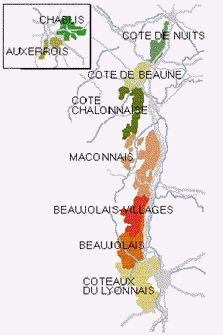Copyright
DKOP L.L.C.
© 1999-2016
• All rights reserved.*
..
The Beaujolais region is found at the southern end of Burgundy in Southeastern France. Almost all of the wines made there are from the Gamay grape variety. These wines are generally very 'fruit forward' and have light tannins. Nearly all of them are ready for consumption on release and will not benefit from additional aging.
Well over half of the wine from the Beaujolais region are sold as 'Beaujolais Nouveau'. It is traditionally the first French wine to be released from each new vintage and is released worldwide on the third Thursday of November. The wine is very fruity, dry and light in body. You can think of it as grape kool-aid with a kick.
Appellations of Beaujolais
Beaujolais
The most basic A.O.C appellation of the region. It must have at least 9% alcohol
Beaujolais Supérieur
Beaujolais Supérieur requires 1% more alcohol than basic Beaujolais.
Beaujolais Villages
Beaujolais-Villages has same alcohol minimum as Superieur but comes from about 40 villages with better soil and microclimates.
Beaujolais Grand Cru
Beaujolais Grand Cru wines come from the ten most celebrated communes, with the best soil and locations.
Brouilly
The area around Mount Brouilly (brew-yee) is one of the largest Grand Cru producers. La Chaize is the largest estate in the Brouilly district. It was completed in 1676 by the same architects that designed Versailles.
Chiroubles
Côte de Brouilly
Fleurie
Juliénas
Chenas
Morgon
Moulin à Vent
Régnié
Saint Amour
